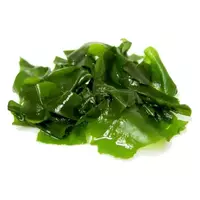Wakame algae

Wakame algae is dark green, almost brown in color and is eaten. It grows off the coast of China, Japan and Korea, and therefore has become widespread in the cuisines of these countries. From winter until the warmest time of the year, wakame algae grows on underwater rocks, often reaching a length of more than 2 meters. In Japanese cuisine, this food has taken its rightful place for centuries.
As a rule, wakame algae is used for food both dried and salted, but fresh it is even tastier. It is added to salads and soups, as well as stewed vegetables. With a refreshing taste and a rather delicate aroma, it is slightly slippery in structure, but is nonetheless as pleasingly crispy as vegetables. Lovers of wakame algae claim that this marine product tastes somewhat like cabbage or spinach. These algae go on sale fresh (in a vacuum), cut into strips or dried. Moreover, it is quite easy to find wakame algae in our stores, due to the increasing demand for Asian food.
Wakame algae is rich in vitamins, minerals and other beneficial elements for humans. It is highly appreciated by people suffering from a lack of iodine in the body. In addition, it contains potassium and fiber in large quantities. And most importantly, wakame algae has practically no contraindications to use. Being a very low-calorie product, this algae is perfect for those people who have made their choice in favor of a healthy lifestyle and follow the figure and weight.
wakame algae 45 kKal
Energy value of wakame algae (Ratio of proteins, fats, carbohydrates - ju):
Proteins: 3.03 g (~ 12 kCal)
Fats: 0.64 g (~ 6 kCal)
Carbohydrates: 8.64 g (~ 35 kCal)
Energy ratio (bj | y): 27% | 13% | 77%
 Español
Español Français
Français Português
Português Русский
Русский 简体中文
简体中文 繁體中文
繁體中文 日本語
日本語 한국어
한국어 العربية
العربية Türkçe
Türkçe Қазақ
Қазақ Deutsch
Deutsch Italiano
Italiano Українська
Українська
